15 August 2024
![]() 9 mins Read
9 mins Read

Red earth, sunshine and quirky characters make Alice Springs a great place to launch an outback road trip.
Sitting at the epicentre of the Explorers Way (a 3000-kilometre route from Adelaide to Darwin, if you are driving north from Alice check out out ultimate Alice to Darwin itinerary), Alice Springs – simply ‘Alice’ to locals – is a popular base for visitors looking to explore the Northern Territory’s outback.
Classic Aussie pubs mix with hip cafes; air-conditioned coaches on their way to the Royal Flying Doctor Service and the Alice Springs School of the Air share the road with cyclists on a tour into the MacDonnell Ranges.
Bird shows at Alice Springs Desert Park and venomous snakes at Alice Springs Reptile Centre wow animal lovers, while history buffs can whittle away hours checking out historic sites such as the National Pioneer Women’s Hall of Fame or the Alice Springs Telegraph Station, where Europeans first settled in town. Throw in sunset atop ANZAC Hill and you’ll be itching to see more of the Red Centre.
Watch competitors race in weird and wonderful floats in the famous Henley-on-Todd Regatta – the world’s only waterless regatta – on the dry Todd River every August.
The town also hosts the annual Alice Springs Camel Cup, a decades-old (and pretty eccentric) tradition perfect for a fun family day out.
If you’re planning on flying into Alice Springs and hiring a vehicle, Apollo Motorhome Holidays, Britz, Thrifty and Hertz all have branches here.
You can easily get from Alice to Uluru in 5.5 hours along the sealed Stuart and Lasseter highways, but where’s the fun in that? Instead, head into the MacDonnell Ranges for an outback adventure bound to leave a lasting impression. The ranges are split in two – the West Macs and the East Macs – and both are impressive.
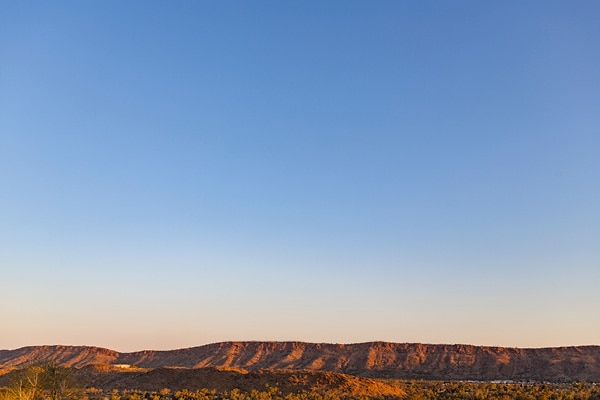
The MacDonnell Ranges are an outback adventure bound to leave a lasting impression.
The better known of the two, the West Macs stretch 200 kilometres and are etched with gorges, chasms and dry creek beds. They can be reached by following the Red Centre Way (an 1135-kilometre loop from Alice).
Places not to miss include the Standley Chasm, a dramatic, 80-metre-high rock face; the refreshing pools at Ellery Creek Big Hole and Ormiston Gorge; and Simpsons Gap, an important spiritual site with several Indigenous dreaming trails.

Places not to miss include the Standley Chasm.
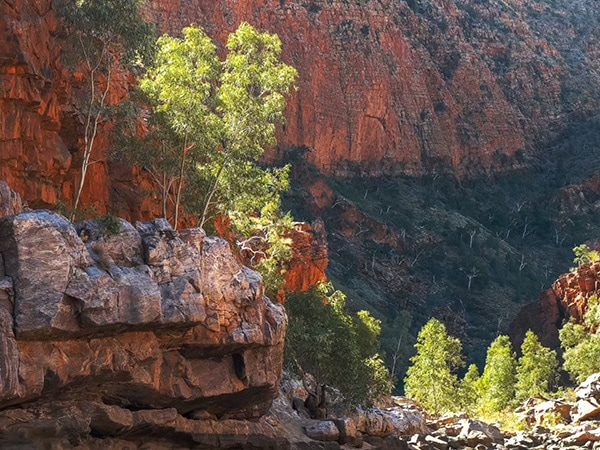
The towering red walls of Ormiston Gorge.
If you’re camping, unfurl a swag and enjoy a campfire at Redbank Gorge. Alternatively, Glen Helen Lodge offers basic accommodation close to Glen Helen Gorge and 1380-metre-high Mt Sonder.
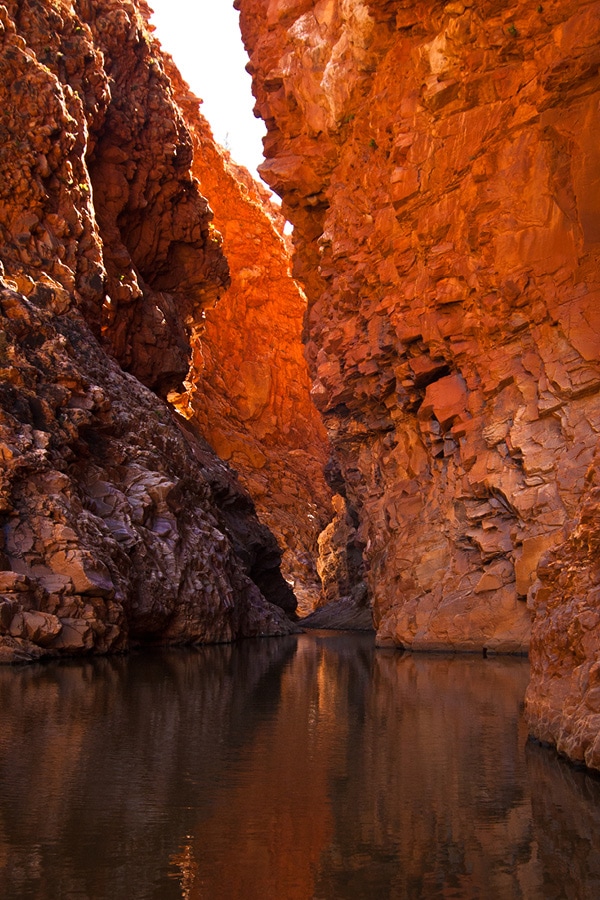
Unfurl a swag and enjoy a campfire at Redbank Gorge.
At around 220 kilometres long, the Larapinta Trail is one of Australia’s legendary hiking routes. Starting in Alice Springs and ending at Mt Sonder, it follows the West Macs and is not for the faint-hearted.
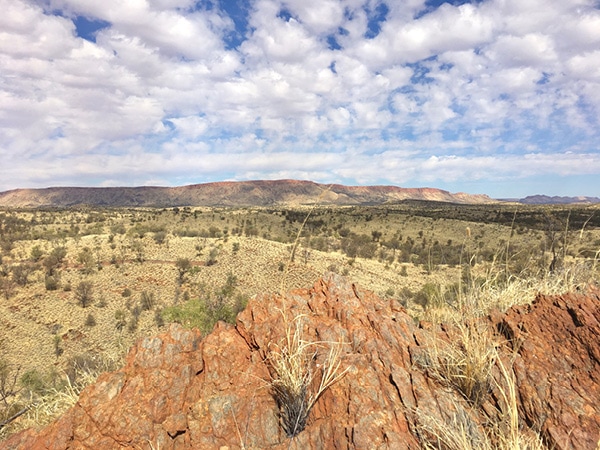
First stop on the Larapinta Trail: Euro Ridge.
Hikers need to fill up water bottles at tanks along the way and organise food drops. The Larapinta is broken into 12 sections and the best time to set off is during winter (June–August).
Go it alone or join a tour like those provided by Australian Walking Holidays, which offer semi-permanent campsites, including Sonder Camp.
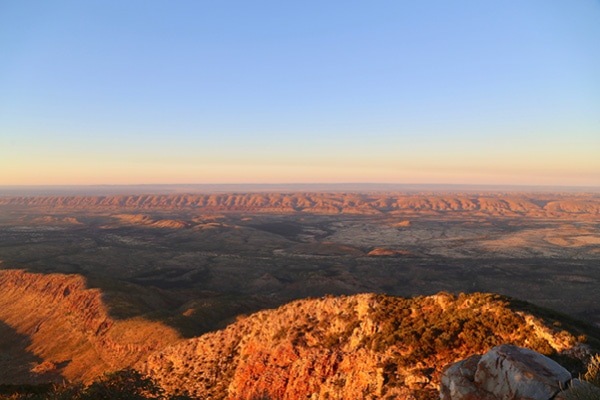
The view from Mt Sonder.
Alice Springs Helicopters offer scenic flights over the MacDonnell Ranges and thrilling mountain bike tours that drop you at sections along the mountain biking trails in the West Macs area.
Less touristed, but arguably as stunning, the East Macs offer travellers insight into the Indigenous and gold rush history of the area.
Located 150 kilometres east of Alice Springs, bushwalking, camping and four-wheel driving is to be expected here. Tag along with a local or tour guide (we recommend Outback Elite Tours) for the ultimate adventure.
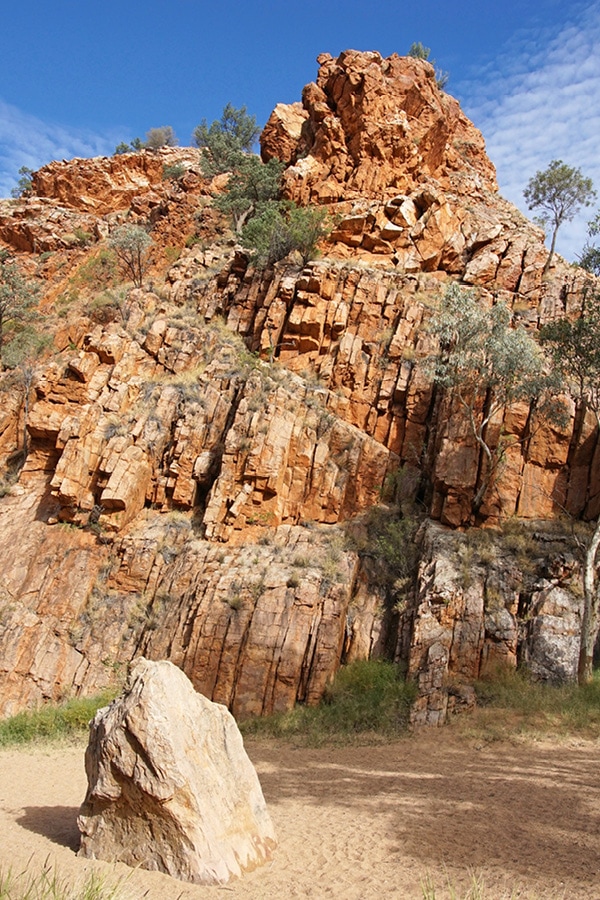
Less touristed than the West Macs, but arguably as stunning.
A main attraction is Trephina Gorge Nature Park, where you’ll be surrounded by rising walls of red and purple quartzite. The gorge is also home to what’s said to be the largest ghost gum in Australia (at 33 metres high and about 300 years old) and forms part of the Wallaby Dreaming Trail, significant to the Eastern Arrernte Aboriginal people.

A main attraction of the East Macs is Trephina Gorge Nature Park.
While you’re here, visit N’Dhala Gorge Nature Park, home to 6000 rock carvings, as well as the old gold rush town of Arltunga, which dates back to the late 1800s, and Hale River Homestead, where you can grab a burger (booking ahead is recommended for meals).
Thought to be 350 million years old, The Finke River winds through Finke Gorge National Park, an important wilderness reserve between Alice Springs and Kings Canyon. Within the park’s confines is the ancient Palm Valley, where rare red cabbage palms, also dating back millennia, grow.
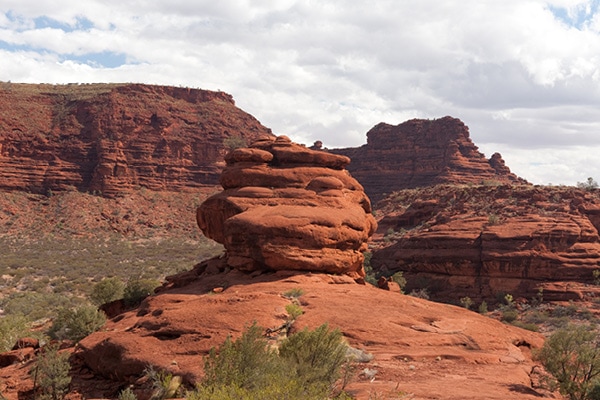
Palm valley in the Finke Gorge National Park.
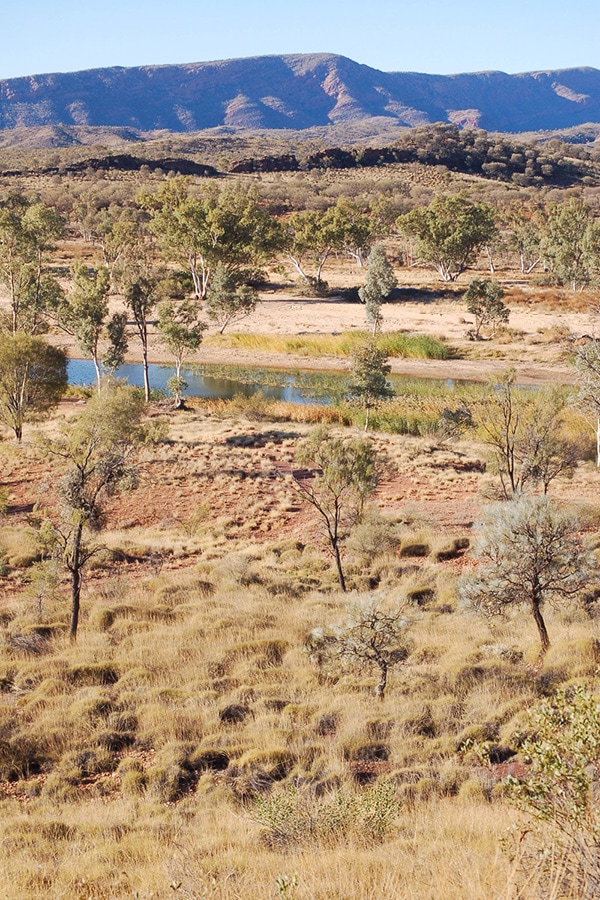
Palm Valley: home to the ancient Red Cabbage Palm.
To get into the park, you’ll need a high-clearance 4WD and be comfortable conquering rocky tracks. You will also want sturdy hiking boots as there are a tonne of trails.
Call into Hermannsburg prior to entering the park: it’s a historic precinct where a Lutheran Mission was active in the late 1880s and where renowned Aboriginal artist Albert Namatjira resided.
After exploring the West Macdonnell Ranges head off-road along the Mereenie Loop as you make your way to Kings Canyon (you’ll need a 4WD and a permit). The canyon, plunging 270 metres, is the highlight of the park and an oasis of palms and ferns.
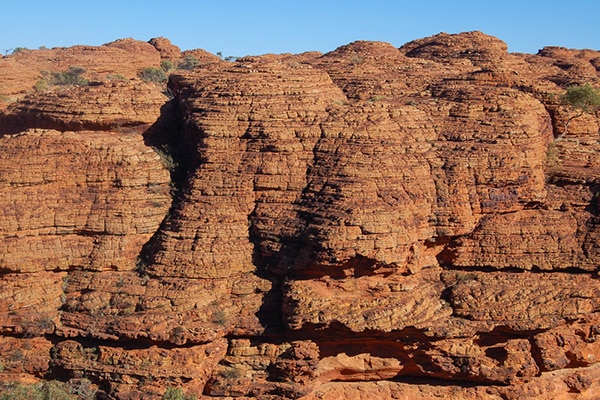
The canyon, plunging 270 metres, is the highlight of the park.
Rise early and set off on the six-kilometre Canyon Rim Walk, which will lead you to the sandstone domes of the Lost City and a sacred watering hole aptly named the Garden of Eden. There is also the much gentler 2.6-kilometre Kings Creek Hike to a lookout.
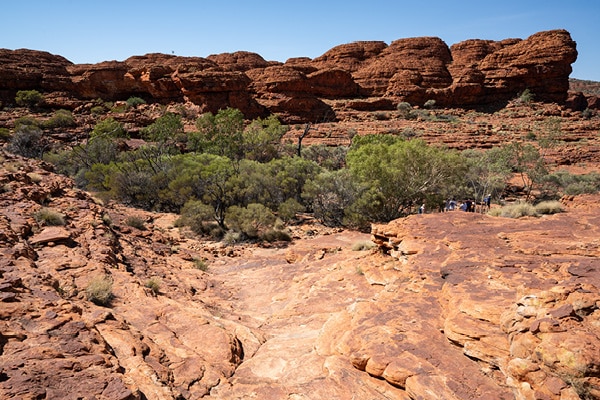
Take the Canyon Rim Walk to the sandstone domes of the Lost City.
Base yourself at Kings Creek Station, not far from Watarrka National Park. The 1800-square-kilometre property is open year-round and is a top spot to experience life on the land with both campsites and basic cabins available. Make time to enjoy traditional damper with a cup of billy tea.
Nothing says ‘outback’ more than the big red rock in the middle of the country, and a road trip here is the best way to appreciate its isolation and imposing beauty as it rises 348 metres from the desert.
In spite of its remoteness, there is plenty to do at UNESCO World Heritage-listed Uluṟu. First up, you’ll want to explore on foot, so rise early and join a guided tour around a portion of Uluru’s 10-kilometre base. The daily Mala Walk (two kilometres) is a good option if you want to learn about Uluru’s cultural significance and Indigenous rock art.
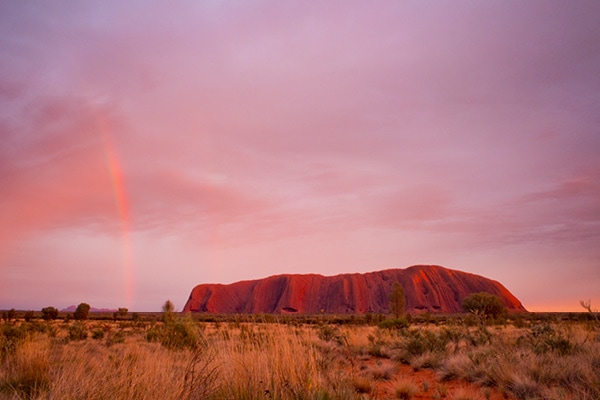
A outback road trip wouldn’t be the same without visiting Uluru.
While you’re there, sign up for a plod atop a camel for what Uluru Camel Tours director Mark Swindells describes as being “like a magic carpet ride”.
For something different, hop aboard a Segway, enjoy a Harley Davidson ride or plummet toward Uluru on a thrilling sky dive. If you want tips on how to extract as much of the magic of this place in a short period of time, we’ve written a 3-day Uluṟu itinerary based on our own trip here.
Set your alarm so you can watch Uluru change colour at sunrise. Drive to one of the viewing platforms, or join the Desert Awakenings Tour.
Another highlight is artist Bruce Munro’s Field of Light where a carpet of 50,000 lights will shine around Uluru until December 2020. Book through Ayers Rock Resort.
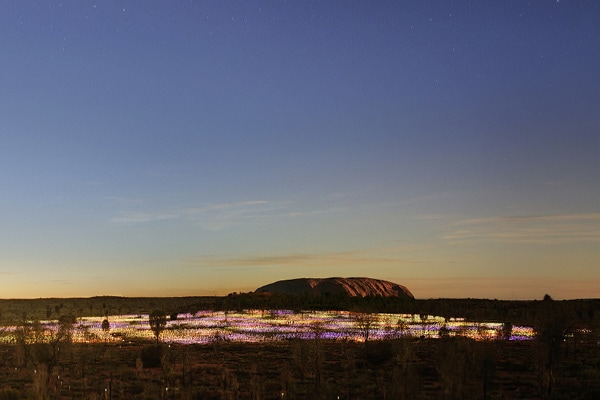
Field of Light; one of the largest art installations in Australia’s history.
For a special outback dining experience, you can’t go past Sounds of Silence. Savour native Australian ingredients, such as kangaroo, finger lime and lemon myrtle, while the Milky Way dazzles from above.
Accommodation in Uluṟu comes in all shapes and sizes, from luxury suites, to tent-style pavilions and campsites. It also runs numerous tours and workshops, some of which are free. Squeeze it all in by jumping on the resort’s complimentary shuttle, especially if you’re travelling with children or the elderly.
Although Uluru is open to visitors year-round, in summer temperatures frequently sit at 45°C and flies are at their most persistent. Instead, visit between May and October, when daytime temperatures are comfortable.
If a one-way road trip from Alice to Uluru is enough for you, fly out of Ayers Rock Airport to many of Australia’s major cities.
If you can squeeze it in, don’t miss the 36 large rock domes of Kata Tjuta – more commonly known as The Olgas. Located about half an hour’s drive from Uluru, they’re easy to reach on a day trip.
The domes are dramatic, with the tallest one, Mt Olga, soaring 546 metres high. Explore them on foot by following the challenging Valley of the Winds trail (7.4 kilometres). It will take you about three hours, so set off early to avoid the midday heat. There is also the easier Walpa Gorge (2.6-kilometre) walk.
If the idea of hiring a car and driving into the outback makes you nervous, but you don’t want to miss out on this special part of Australia, there are plenty of tour companies willing to do the hard yards for you.
AAT Kings coach tours are comprehensive and reliable, as are those offered by G Adventures. Seit Outback Australia specialises in small-group tours.
LEAVE YOUR COMMENT